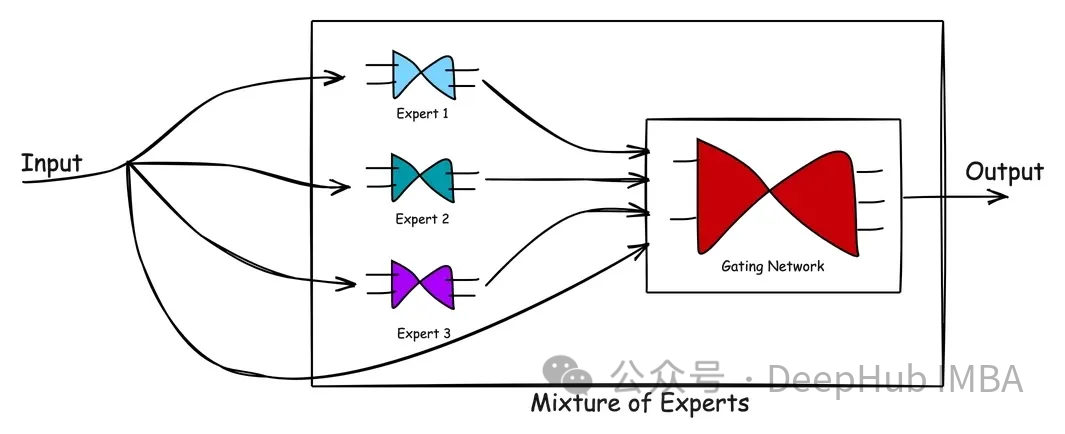利用PyTorch实现混合专家模型(MoE)
Mixtral 8x7B的推出在开放AI领域引起了广泛关注,特别是混合专家(Mixture-of-Experts:MoEs)这一概念被大家所熟知。混合专家(MoE)概念象征着协作智能,体现了整体大于部分之和的理念。MoE模型整合了多种专家模型的优势,以提供更准确的预测。它由一个门控网络和一组专家网络构成,每个专家网络都擅长处理特定任务的不同方面。通过合理分配任务和权重,MoE模型能够利用专家的特长,从而提高整体的预测性能。这种协作式的智能模型为AI领域的发展带来了新的突破,将在未来的应用中发挥重要作用。
本文将使用PyTorch实现MoE模型。在介绍具体代码前,先简单介绍混合专家的体系结构。
MoE架构
MoE由两种类型的网络组成:(1)专家网络和(2)门控网络。
专家网络是一种采用专有模型的方法,在数据的一个子集中得到良好的表现。它的核心理念是通过多个优势互补的专家来覆盖问题空间,确保全面解决问题。每个专家模型经过训练,具备独特的能力和经验,从而提高整体系统的性能和效果。通过专家网络的使用,可以有效地应对复杂的任务和需求,提供更好的解决方案。
门控网络是一种用于指挥、协调或管理专家贡献的网络。它通过学习和权衡不同网络对不同类型输入的处理能力,来决定哪个网络最擅长处理特定的输入。训练有素的门控网络可以评估新的输入向量,并根据专家的熟练程度将处理任务分配给最合适的专家或专家组合。门控网络会根据专家的输出与当前输入的相关性动态调整权重,以确保个性化的响应。这种动态调整权重的机制使得门控网络能够灵活地适应不同的情境和需求。

上图显示了MoE中的处理流程。混合专家模型的优点在于它的简单。通过学习复杂的问题空间以及专家在解决问题时的反应,MoE模型有助于产生比单个专家更好的解决方案。门控网络作为一个有效的管理者,评估情景并将任务传递给最佳专家。当新数据输入时,模型可以通过重新评估专家对新输入的优势来适应,从而产生灵活的学习方法。 简而言之,MoE模型利用多个专家的知识和经验来解决复杂的问题。通过一个门控网络的管理,模型能够根据不同的情景选择最适合的专家来处理任务。这种方法的优势在于它能够产生比单个专家更好的解决方案,并且能够灵活地适应新的输入数据。总的来说,MoE模型是一种有效且简单的方法,可以用于解决各种复杂的问题。
MoE为部署机器学习模型提供了巨大的好处。以下是两个显著的好处。
MoE的核心优势在于其多元化和专业化的专家网络。MoE的设置能够高精度地处理多个领域的问题,这是单一模型难以达到的。
MoE具有固有的可伸缩性。随着任务复杂性的增加,更多的专家可以无缝地集成到系统中,扩大专业知识的范围,而不需要改变其他专家模型。换句话说,MoE能够将预先训练过的专家打包到机器学习系统中,帮助系统应对不断增长的任务要求。
混合专家模型在许多领域都有应用,包括推荐系统、语言建模和各种复杂的预测任务。有传言称,GPT-4是由多个专家组成的。尽管我们无法确认,但类似gpt -4的模型将通过MoE方法利用多个模型的力量来提供最佳结果。
Pytorch代码
我们这里不讨论Mixtral 8x7B这种大模型中使用的MOE技术,而是我们编写一个简单的、可以应用在任何任务中的自定义MOE,通过代码我们可以了解MOE的工作原理,这样对理解MOE在大模型中的工作方式是非常有帮助的。
下面我们将一段一段地介绍PyTorch的代码实现。
导入库:
import torch import torch.nn as nn import torch.optim as optim
定义专家模型:
class Expert(nn.Module): def __init__(self, input_dim, hidden_dim, output_dim): super(Expert, self).__init__() self.layer1 = nn.Linear(input_dim, hidden_dim) self.layer2 = nn.Linear(hidden_dim, output_dim) def forward(self, x): x = torch.relu(self.layer1(x)) return torch.softmax(self.layer2(x), dim=1)
这里我们定义了一个简单的专家模型,可以看到它是一个2层的mlp,使用了relu激活,最后使用softmax输出分类概率。
定义门控模型:
# Define the gating model class Gating(nn.Module): def __init__(self, input_dim,num_experts, dropout_rate=0.1): super(Gating, self).__init__() # Layers self.layer1 = nn.Linear(input_dim, 128) self.dropout1 = nn.Dropout(dropout_rate) self.layer2 = nn.Linear(128, 256) self.leaky_relu1 = nn.LeakyReLU() self.dropout2 = nn.Dropout(dropout_rate) self.layer3 = nn.Linear(256, 128) self.leaky_relu2 = nn.LeakyReLU() self.dropout3 = nn.Dropout(dropout_rate) self.layer4 = nn.Linear(128, num_experts) def forward(self, x): x = torch.relu(self.layer1(x)) x = self.dropout1(x) x = self.layer2(x) x = self.leaky_relu1(x) x = self.dropout2(x) x = self.layer3(x) x = self.leaky_relu2(x) x = self.dropout3(x) return torch.softmax(self.layer4(x), dim=1)
门控模型更复杂,有三个线性层和dropout层用于正则化以防止过拟合。它使用ReLU和LeakyReLU激活函数引入非线性。最后一层的输出大小等于专家的数量,并对这些输出应用softmax函数。输出权重,这样可以将专家的输出与之结合。
说明:其实门控网络,或者叫路由网络是MOE中最复杂的部分,因为它涉及到控制输入到那个专家模型,所以门控网络也有很多个设计方案,例如(如果我没记错的话)Mixtral 8x7B 只是取了8个专家中的top2。所以我们这里不详细讨论各种方案,只是介绍其基本原理和代码实现。
完整的MOE模型:
class MoE(nn.Module): def __init__(self, trained_experts): super(MoE, self).__init__() self.experts = nn.ModuleList(trained_experts) num_experts = len(trained_experts) # Assuming all experts have the same input dimension input_dim = trained_experts[0].layer1.in_features self.gating = Gating(input_dim, num_experts) def forward(self, x): # Get the weights from the gating network weights = self.gating(x) # Calculate the expert outputs outputs = torch.stack([expert(x) for expert in self.experts], dim=2) # Adjust the weights tensor shape to match the expert outputs weights = weights.unsqueeze(1).expand_as(outputs) # Multiply the expert outputs with the weights and # sum along the third dimension return torch.sum(outputs * weights, dim=2)
这里主要看前向传播的代码,通过输入计算出权重和每个专家给出输出的预测,最后使用权重将所有专家的结果求和最终得到模型的输出。
这个是不是有点像“集成学习”。
测试
下面我们来对我们的实现做个简单的测试,首先生成一个简单的数据集:
# Generate the dataset num_samples = 5000 input_dim = 4 hidden_dim = 32 # Generate equal numbers of labels 0, 1, and 2 y_data = torch.cat([ torch.zeros(num_samples // 3), torch.ones(num_samples // 3), torch.full((num_samples - 2 * (num_samples // 3),), 2)# Filling the remaining to ensure exact num_samples ]).long() # Biasing the data based on the labels x_data = torch.randn(num_samples, input_dim) for i in range(num_samples): if y_data[i] == 0: x_data[i, 0] += 1# Making x[0] more positive elif y_data[i] == 1: x_data[i, 1] -= 1# Making x[1] more negative elif y_data[i] == 2: x_data[i, 0] -= 1# Making x[0] more negative # Shuffle the data to randomize the order indices = torch.randperm(num_samples) x_data = x_data[indices] y_data = y_data[indices] # Verify the label distribution y_data.bincount() # Shuffle the data to ensure x_data and y_data remain aligned shuffled_indices = torch.randperm(num_samples) x_data = x_data[shuffled_indices] y_data = y_data[shuffled_indices] # Splitting data for training individual experts # Use the first half samples for training individual experts x_train_experts = x_data[:int(num_samples/2)] y_train_experts = y_data[:int(num_samples/2)] mask_expert1 = (y_train_experts == 0) | (y_train_experts == 1) mask_expert2 = (y_train_experts == 1) | (y_train_experts == 2) mask_expert3 = (y_train_experts == 0) | (y_train_experts == 2) # Select an almost equal number of samples for each expert num_samples_per_expert = \ min(mask_expert1.sum(), mask_expert2.sum(), mask_expert3.sum()) x_expert1 = x_train_experts[mask_expert1][:num_samples_per_expert] y_expert1 = y_train_experts[mask_expert1][:num_samples_per_expert] x_expert2 = x_train_experts[mask_expert2][:num_samples_per_expert] y_expert2 = y_train_experts[mask_expert2][:num_samples_per_expert] x_expert3 = x_train_experts[mask_expert3][:num_samples_per_expert] y_expert3 = y_train_experts[mask_expert3][:num_samples_per_expert] # Splitting the next half samples for training MoE model and for testing x_remaining = x_data[int(num_samples/2)+1:] y_remaining = y_data[int(num_samples/2)+1:] split = int(0.8 * len(x_remaining)) x_train_moe = x_remaining[:split] y_train_moe = y_remaining[:split] x_test = x_remaining[split:] y_test = y_remaining[split:] print(x_train_moe.shape,"\n", x_test.shape,"\n", x_expert1.shape,"\n", x_expert2.shape,"\n", x_expert3.shape)
这段代码创建了一个合成数据集,其中包含三个类标签——0、1和2。基于类标签对特征进行操作,从而在数据中引入一些模型可以学习的结构。
数据被分成针对个别专家的训练集、MoE模型和测试集。我们确保专家模型是在一个子集上训练的,这样第一个专家在标签0和1上得到很好的训练,第二个专家在标签1和2上得到更好的训练,第三个专家看到更多的标签2和0。
我们期望的结果是:虽然每个专家对标签0、1和2的分类准确率都不令人满意,但通过结合三位专家的决策,MoE将表现出色。
模型初始化和训练设置:
# Define hidden dimension output_dim = 3 hidden_dim = 32 epochs = 500 learning_rate = 0.001 # Instantiate the experts expert1 = Expert(input_dim, hidden_dim, output_dim) expert2 = Expert(input_dim, hidden_dim, output_dim) expert3 = Expert(input_dim, hidden_dim, output_dim) # Set up loss criterion = nn.CrossEntropyLoss() # Optimizers for experts optimizer_expert1 = optim.Adam(expert1.parameters(), lr=learning_rate) optimizer_expert2 = optim.Adam(expert2.parameters(), lr=learning_rate) optimizer_expert3 = optim.Adam(expert3.parameters(), lr=learning_rate)
实例化了专家模型和MoE模型。定义损失函数来计算训练损失,并为每个模型设置优化器,在训练过程中执行权重更新。
训练的步骤也非常简单
# Training loop for expert 1 for epoch in range(epochs):optimizer_expert1.zero_grad()outputs_expert1 = expert1(x_expert1)loss_expert1 = criterion(outputs_expert1, y_expert1)loss_expert1.backward()optimizer_expert1.step() # Training loop for expert 2 for epoch in range(epochs):optimizer_expert2.zero_grad()outputs_expert2 = expert2(x_expert2)loss_expert2 = criterion(outputs_expert2, y_expert2)loss_expert2.backward()optimizer_expert2.step() # Training loop for expert 3 for epoch in range(epochs):optimizer_expert3.zero_grad()outputs_expert3 = expert3(x_expert3)loss_expert3 = criterion(outputs_expert3, y_expert3)loss_expert3.backward()
每个专家使用基本的训练循环在不同的数据子集上进行单独的训练。循环迭代指定数量的epoch。
下面是我们MOE的训练
# Create the MoE model with the trained experts moe_model = MoE([expert1, expert2, expert3]) # Train the MoE model optimizer_moe = optim.Adam(moe_model.parameters(), lr=learning_rate) for epoch in range(epochs):optimizer_moe.zero_grad()outputs_moe = moe_model(x_train_moe)loss_moe = criterion(outputs_moe, y_train_moe)loss_moe.backward()optimizer_moe.step()
MoE模型是由先前训练过的专家创建的,然后在单独的数据集上进行训练。训练过程类似于单个专家的训练,但现在门控网络的权值在训练过程中更新。
最后我们的评估函数:
# Evaluate all models def evaluate(model, x, y):with torch.no_grad():outputs = model(x)_, predicted = torch.max(outputs, 1)correct = (predicted == y).sum().item()accuracy = correct / len(y)return accuracy
evaluate函数计算模型在给定数据上的精度(x代表样本,y代表预期标签)。准确度计算为正确预测数与预测总数之比。
结果如下:
accuracy_expert1 = evaluate(expert1, x_test, y_test) accuracy_expert2 = evaluate(expert2, x_test, y_test) accuracy_expert3 = evaluate(expert3, x_test, y_test) accuracy_moe = evaluate(moe_model, x_test, y_test) print("Expert 1 Accuracy:", accuracy_expert1) print("Expert 2 Accuracy:", accuracy_expert2) print("Expert 3 Accuracy:", accuracy_expert3) print("Mixture of Experts Accuracy:", accuracy_moe) #Expert 1 Accuracy: 0.466 #Expert 2 Accuracy: 0.496 #Expert 3 Accuracy: 0.378 #Mixture of Experts Accuracy: 0.614可以看到
专家1正确预测了测试数据集中大约46.6%的样本的类标签。
专家2表现稍好,正确预测率约为49.6%。
专家3在三位专家中准确率最低,正确预测的样本约为37.8%。
而MoE模型显著优于每个专家,总体准确率约为61.4%。
总结
我们测试的输出结果显示了混合专家模型的强大功能。该模型通过门控网络将各个专家模型的优势结合起来,取得了比单个专家模型更高的精度。门控网络有效地学习了如何根据输入数据权衡每个专家的贡献,以产生更准确的预测。混合专家利用了各个模型的不同专业知识,在测试数据集上提供了更好的性能。
同时也说明我们可以在现有的任务上尝试使用MOE来进行测试,也可以得到更好的结果。
以上是利用PyTorch实现混合专家模型(MoE)的详细内容。更多信息请关注PHP中文网其他相关文章!

热AI工具

Undresser.AI Undress
人工智能驱动的应用程序,用于创建逼真的裸体照片

AI Clothes Remover
用于从照片中去除衣服的在线人工智能工具。

Undress AI Tool
免费脱衣服图片

Clothoff.io
AI脱衣机

AI Hentai Generator
免费生成ai无尽的。

热门文章

热工具

记事本++7.3.1
好用且免费的代码编辑器

SublimeText3汉化版
中文版,非常好用

禅工作室 13.0.1
功能强大的PHP集成开发环境

Dreamweaver CS6
视觉化网页开发工具

SublimeText3 Mac版
神级代码编辑软件(SublimeText3)

热门话题
 字节跳动剪映推出 SVIP 超级会员:连续包年 499 元,提供多种 AI 功能
Jun 28, 2024 am 03:51 AM
字节跳动剪映推出 SVIP 超级会员:连续包年 499 元,提供多种 AI 功能
Jun 28, 2024 am 03:51 AM
本站6月27日消息,剪映是由字节跳动旗下脸萌科技开发的一款视频剪辑软件,依托于抖音平台且基本面向该平台用户制作短视频内容,并兼容iOS、安卓、Windows、MacOS等操作系统。剪映官方宣布会员体系升级,推出全新SVIP,包含多种AI黑科技,例如智能翻译、智能划重点、智能包装、数字人合成等。价格方面,剪映SVIP月费79元,年费599元(本站注:折合每月49.9元),连续包月则为59元每月,连续包年为499元每年(折合每月41.6元)。此外,剪映官方还表示,为提升用户体验,向已订阅了原版VIP
 使用Rag和Sem-Rag提供上下文增强AI编码助手
Jun 10, 2024 am 11:08 AM
使用Rag和Sem-Rag提供上下文增强AI编码助手
Jun 10, 2024 am 11:08 AM
通过将检索增强生成和语义记忆纳入AI编码助手,提升开发人员的生产力、效率和准确性。译自EnhancingAICodingAssistantswithContextUsingRAGandSEM-RAG,作者JanakiramMSV。虽然基本AI编程助手自然有帮助,但由于依赖对软件语言和编写软件最常见模式的总体理解,因此常常无法提供最相关和正确的代码建议。这些编码助手生成的代码适合解决他们负责解决的问题,但通常不符合各个团队的编码标准、惯例和风格。这通常会导致需要修改或完善其建议,以便将代码接受到应
 微调真的能让LLM学到新东西吗:引入新知识可能让模型产生更多的幻觉
Jun 11, 2024 pm 03:57 PM
微调真的能让LLM学到新东西吗:引入新知识可能让模型产生更多的幻觉
Jun 11, 2024 pm 03:57 PM
大型语言模型(LLM)是在巨大的文本数据库上训练的,在那里它们获得了大量的实际知识。这些知识嵌入到它们的参数中,然后可以在需要时使用。这些模型的知识在训练结束时被“具体化”。在预训练结束时,模型实际上停止学习。对模型进行对齐或进行指令调优,让模型学习如何充分利用这些知识,以及如何更自然地响应用户的问题。但是有时模型知识是不够的,尽管模型可以通过RAG访问外部内容,但通过微调使用模型适应新的领域被认为是有益的。这种微调是使用人工标注者或其他llm创建的输入进行的,模型会遇到额外的实际知识并将其整合
 七个很酷的GenAI & LLM技术性面试问题
Jun 07, 2024 am 10:06 AM
七个很酷的GenAI & LLM技术性面试问题
Jun 07, 2024 am 10:06 AM
想了解更多AIGC的内容,请访问:51CTOAI.x社区https://www.51cto.com/aigc/译者|晶颜审校|重楼不同于互联网上随处可见的传统问题库,这些问题需要跳出常规思维。大语言模型(LLM)在数据科学、生成式人工智能(GenAI)和人工智能领域越来越重要。这些复杂的算法提升了人类的技能,并在诸多行业中推动了效率和创新性的提升,成为企业保持竞争力的关键。LLM的应用范围非常广泛,它可以用于自然语言处理、文本生成、语音识别和推荐系统等领域。通过学习大量的数据,LLM能够生成文本
 为大模型提供全新科学复杂问答基准与测评体系,UNSW、阿贡、芝加哥大学等多家机构联合推出SciQAG框架
Jul 25, 2024 am 06:42 AM
为大模型提供全新科学复杂问答基准与测评体系,UNSW、阿贡、芝加哥大学等多家机构联合推出SciQAG框架
Jul 25, 2024 am 06:42 AM
编辑|ScienceAI问答(QA)数据集在推动自然语言处理(NLP)研究发挥着至关重要的作用。高质量QA数据集不仅可以用于微调模型,也可以有效评估大语言模型(LLM)的能力,尤其是针对科学知识的理解和推理能力。尽管当前已有许多科学QA数据集,涵盖了医学、化学、生物等领域,但这些数据集仍存在一些不足。其一,数据形式较为单一,大多数为多项选择题(multiple-choicequestions),它们易于进行评估,但限制了模型的答案选择范围,无法充分测试模型的科学问题解答能力。相比之下,开放式问答
 你所不知道的机器学习五大学派
Jun 05, 2024 pm 08:51 PM
你所不知道的机器学习五大学派
Jun 05, 2024 pm 08:51 PM
机器学习是人工智能的重要分支,它赋予计算机从数据中学习的能力,并能够在无需明确编程的情况下改进自身能力。机器学习在各个领域都有着广泛的应用,从图像识别和自然语言处理到推荐系统和欺诈检测,它正在改变我们的生活方式。机器学习领域存在着多种不同的方法和理论,其中最具影响力的五种方法被称为“机器学习五大派”。这五大派分别为符号派、联结派、进化派、贝叶斯派和类推学派。1.符号学派符号学(Symbolism),又称为符号主义,强调利用符号进行逻辑推理和表达知识。该学派认为学习是一种逆向演绎的过程,通过已有的
 SOTA性能,厦大多模态蛋白质-配体亲和力预测AI方法,首次结合分子表面信息
Jul 17, 2024 pm 06:37 PM
SOTA性能,厦大多模态蛋白质-配体亲和力预测AI方法,首次结合分子表面信息
Jul 17, 2024 pm 06:37 PM
编辑|KX在药物研发领域,准确有效地预测蛋白质与配体的结合亲和力对于药物筛选和优化至关重要。然而,目前的研究没有考虑到分子表面信息在蛋白质-配体相互作用中的重要作用。基于此,来自厦门大学的研究人员提出了一种新颖的多模态特征提取(MFE)框架,该框架首次结合了蛋白质表面、3D结构和序列的信息,并使用交叉注意机制进行不同模态之间的特征对齐。实验结果表明,该方法在预测蛋白质-配体结合亲和力方面取得了最先进的性能。此外,消融研究证明了该框架内蛋白质表面信息和多模态特征对齐的有效性和必要性。相关研究以「S
 PRO | 为什么基于 MoE 的大模型更值得关注?
Aug 07, 2024 pm 07:08 PM
PRO | 为什么基于 MoE 的大模型更值得关注?
Aug 07, 2024 pm 07:08 PM
2023年,几乎AI的每个领域都在以前所未有的速度进化,同时,AI也在不断地推动着具身智能、自动驾驶等关键赛道的技术边界。多模态趋势下,Transformer作为AI大模型主流架构的局面是否会撼动?为何探索基于MoE(专家混合)架构的大模型成为业内新趋势?大型视觉模型(LVM)能否成为通用视觉的新突破?...我们从过去的半年发布的2023年本站PRO会员通讯中,挑选了10份针对以上领域技术趋势、产业变革进行深入剖析的专题解读,助您在新的一年里为大展宏图做好准备。本篇解读来自2023年Week50






